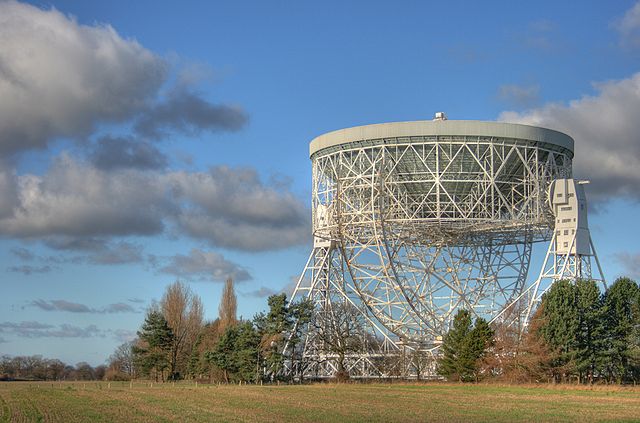Top Qs
Timeline
Chat
Perspective
Department of Physics and Astronomy, University of Manchester
Department of the University of Manchester From Wikipedia, the free encyclopedia
Remove ads
The Department of Physics and Astronomy at the University of Manchester is one of the largest and most active physics departments in the UK, taking around 330 new undergraduates and 50 postgraduates each year, and employing more than 80 members of academic staff and over 100 research fellows and associates.[2] The department is based on two sites: the Schuster Laboratory on Brunswick Street and the Jodrell Bank Centre for Astrophysics in Cheshire, international headquarters of the Square Kilometre Array (SKA).[3]
According to the Academic Ranking of World Universities, the department is the 9th best physics department in the world and best in Europe.[4] It is ranked 2nd place in the UK by Grade Point Average (GPA) according to the Research Excellence Framework (REF) in 2021, being only behind the University of Sheffield.[5] The University has a long history of physics dating back to 1874, which includes 12 Nobel Prize laureates,[6] most recently Andre Geim and Konstantin Novoselov who were awarded the Nobel Prize in Physics in 2010 for their discovery of graphene.[7][8]
Remove ads
Research groups
Summarize
Perspective

The Department of Physics and Astronomy comprises eight research groups:
- Astronomy and Astrophysics
- Biological Physics
- Condensed Matter Physics
- Nonlinear Dynamics and Liquid Crystal Physics
- Photon Physics
- Particle Physics
- Nuclear Physics
- Theoretical Physics
Research in the department of Physics has been funded by the Particle Physics and Astronomy Research Council (PPARC), the Science and Technology Facilities Council (STFC)[9] and the Royal Society.
Notable faculty

As of 2015[update] the department employs 53 Professors, including Emeritus Professors.[10]
- Teresa Anderson Professor of Physics and co-founder of the Bluedot Festival
- Philippa Browning Professor Astrophysics
- Brian Cox,[11] Professor of Particle Physics, working on the ATLAS experiment at the Large Hadron Collider
- Philip Diamond,[12] Professor of Photon Physics and Director General of the Square Kilometre Array (SKA)
- Wendy Flavell, Vice Dean for Research and a Professor of Surface Physics[13]
- Jeffrey Forshaw,[11] Professor of Particle Physics and co-author of The Quantum Universe
- Sir Andre Geim,[14] Regius Professor & Royal Society Research Professor
- Sir Konstantin Novoselov,[15] Langworthy Professor of Physics
- Tim O'Brien, Professor of Astrophysics
- Sean Freeman, Professor of Nuclear Physics
- Terry Wyatt Professor of Particle Physics[16]
Notable alumni and former staff
- Sarah Bridle, Professor of Food, Climate and Society at the University of York
- Neil Burgess, University College London
- Tamsin Edwards, King's College London
- Yvonne Elsworth, University of Birmingham
- Danielle George, Professor of Radiofrequency Engineering
Remove ads
History
Summarize
Perspective

The department has origins dating back to 1874 when Balfour Stewart was appointed the first Langworthy Professor of Physics at Owens College, Manchester. Stewart was the first to identify an electrified atmospheric layer (now known as the ionosphere) which could distort the Earth's magnetic field. The theory of the ionosphere was postulated by Carl Friedrich Gauss in 1839, Stewart published the first experimental confirmation of the theory in 1878.[18] Since then, the department has hosted many award-winning scientists[18] including:
- Hans Bethe,[19] awarded the Nobel Prize in Physics in 1967
- Patrick Blackett, Baron Blackett,[20] awarded the Nobel Prize in Physics in 1948
- Niels Bohr,[21] awarded the Nobel Prize in Physics in 1922
- Sir William Lawrence Bragg,[22] discovered Bragg's law and awarded the Nobel Prize in Physics in 1915
- Sir James Chadwick,[23] awarded the Nobel Prize in Physics in 1935
- Sir John Cockcroft,[24] awarded the Nobel Prize in Physics in 1951
- Rod Davies,[25] Professor of Radio Astronomy
- Richard Davis, Professor of Astrophysics
- Samuel Devons,
- Brian Flowers, Baron Flowers,[26]
- Sir Francis Graham-Smith,[27] Astronomer Royal from 1982 to 1990
- Henry Hall,[28] who built the first dilution refrigerator[18]
- Sir Bernard Lovell,[29][30] creator of the Lovell Telescope at the Jodrell Bank Observatory
- Henry Moseley,[31] creator of Moseley's law
- Nevill Francis Mott,[32] awarded the Nobel Prize in Physics in 1977
- Ernest Rutherford,[33] awarded the Nobel Prize in Chemistry in 1908 for splitting the atom
- Sir Arthur Schuster,[34]
- Balfour Stewart,[35] first Langworthy Professor of Physics
- Sir Joseph John "J. J." Thomson,[36] studied Physics at Owens College, Manchester aged 14, went on to run the Cavendish Laboratory in Cambridge and was awarded the 1906 Nobel Prize in Physics.
In 2004, the two separate departments of Physics at the Victoria University of Manchester and the University of Manchester Institute of Science and Technology (UMIST) were merged to form the current Department of Physics and Astronomy at the University of Manchester. The department was known as the School of Physics and Astronomy until a 2019 reshuffle.
Emeritus professors
The department is also home to several Emeritus Scientists, pursuing their research interests after their formal retirement including:
- Alexander Donnachie,[37] Research Professor
- Andrew Lyne,[38] Emeritus Professor and co-discoverer of the binary pulsar
- Robin Marshall,[39] Professor of Physics and Biology
- Michael Moore,[40] Emeritus Professor of Theoretical Physics
Remove ads
References
Wikiwand - on
Seamless Wikipedia browsing. On steroids.
Remove ads

